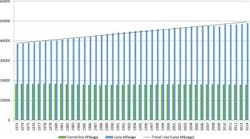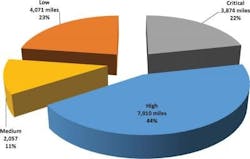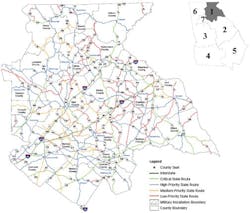Setting priorities
Among the public trusts that touch the lives of pretty much every American, by either circumstance or necessity, the highway and road infrastructure system is arguably the most crucial.
Its maintenance is therefore of the utmost importance to each state-level department of transportation. As such, a working priority scheme is essential to overall system health. The question is how to do it.
The state of Georgia has become both a destination and a key hub for international travel and commerce. Atlanta’s airport is among the busiest in the world and the shipping ports of Brunswick and Savannah are among the nation’s leading and fastest growing. Pedestrians, bicyclists, motorists, commercial truckers, airports and harbors all depend on a reliable, efficient and safe road system.
The Georgia State Highway System consists of a mixture of roads, including multi-lane interstates, business spurs and two-lane roads. The Georgia Department of Transportation (GDOT) maintains records of all roads by type. Although GDOT only owns 19% of the total lane mileage, 61% of the total vehicle miles traveled within the state are on these roads.
Since the 1970s, GDOT has maintained the entire state highway system centerline mileage at approximately 18,000 miles through the transfer of ownership with local governments. GDOT carefully balances the bulk of the state-owned mileage through negotiations and transfers to local governments; however, mileage is added to the system as additional lane-miles are constructed (Figure 1).
Figure 1. Georgia statewide route centerline and lane mileage for the period 1973-2014.
All states strive to have a state highway system with a well-connected network of high-quality roads that complies with state codes and federal law. Roads that play a significant role in freight movement, intrastate travel or have a federal designation should be given a high priority. Conversely, a state route should not function as a neighborhood street or an unconnected road not serving a population center. Roads carrying extremely low traffic volumes or those that do not meet current design standards should be evaluated to determine if they should remain a part of the state highway system.
An effort spurred by GDOT’s Office of Transportation Data (OTD) initiated a research project to answer three simple questions on the road, as it were, toward a state highway prioritization system:
- Which routes have a higher priority?
- Which routes have a lower priority? and
- What are the criteria?
A cohesive process
On March 12, 2014, the OTD invited participants from other GDOT offices to provide their thoughts on the state route analysis and prioritization efforts. To evaluate a system, it is first necessary to define the essential components, or for the purpose of this study, what can be identified as a high-priority state route. For example, interstates and U.S. routes would be obvious high-priority components of the network. Participants also suggested freight corridors, the National Highway System and the Georgia Emergency Management Agency’s critical roads.
Participants established a second grouping of roads: the medium-priority state routes. This category is comprised of roads that are important to the state highway system but have a lower priority. Hurricane evacuation routes and low-volume National Highway System routes were identified as medium-priority state routes.
The participants established a third category: low-priority state routes. This category may have one or more of the following characteristics: low traffic volumes, low connectivity, short lengths or low speed limit. Participants recommended that the focus should not only be on identifying priority roads but also should identify roads that could be appropriate candidates for potential transfer to a local government. Individuals cited several specific examples of low-volume roads traveling through a residential “Main Street type” area. Further consideration should be given to the low-priority state routes to determine if particular routes should remain as part of the state highway system, or if they should be reclassified.
Participants initially proposed other criteria but ultimately discarded the suggestions. The group proposed various economic and mobility criteria for consideration, but they concluded that sources of information would be difficult to locate, maintain and update. The group also concluded that identifying geographic areas with greater tourism, memorial or economic impacts may not be adequate criteria for determining state route priority.
The OTD was unable to identify data sources for a couple of the proposed criteria. Participants considered that roads in south Georgia might have originally provided or still provide access for freight trucks traveling to and from logging or agricultural product areas. However, the OTD was unable to identify a data source for the farm-to-market routes that these heavy-load trucks are traveling. The group also recommended that state routes connecting to regional hospitals should be medium priority, but the OTD was unable to find a statewide GIS authoritative source for the data.
Data and map analysis
The OTD created an initial draft of the State Prioritization Network based upon the criteria described above. The draft showed the breakdown among the high-priority, medium-priority and low-priority state routes. As recommended by the workshop participants, the OTD sent the draft map to each of GDOT’s seven districts, the Office of Maintenance and the Office of Planning for review and comments. After receiving their feedback, the OTD researched and resolved a few cases where suggestions had overlaps or conflicts. Additionally, executive management reviewed the maps and recommended that routes identified as national freight routes, state freight routes, interstates and intermodal connectors be separated from the other high-priority state routes in order to create a fourth category, critical state routes.
The OTD further refined the rules for continuity on the State Route Prioritization Network. For example, although one or more routes may run in common, the network map can display only one category. State routes also may be routed through a 90° right or left turn (e.g., S.R. 30 in Chatham County) which causes a disjointed appearance. Some of the criteria, such as traffic volume, dynamically change along the length of a road, causing fluctuations between two categories. A route with annual average daily traffic (AADT) that varied from 2,000 to 4,000 from the beginning to the end could fluctuate between medium and low at every traffic segment break. In these cases, the OTD assigned a category based upon the predominate condition.
Figure 2. Georgia state routes by priority, in miles.
Discussion of results
The OTD categorized state routes into critical, high, medium and low priorities, and established a sequence of criteria therefore:
Critical State Routes
- National freight corridors
- State freight corridors
- Interstates
- Intermodal connectors
High-priority State Routes
- STRAHNET/STRAHNET connectors
- NHS-Other principal arterials
- (AADT > 3,000)
- U.S. routes
- Sole connections between county seats
- Georgia Emergency Management Agency nuclear power plant evacuation routes
Medium-priority State Routes
- Hurricane evacuation routes
- NHS–Other principal arterial routes beginning or ending at a low priority state route
- NHS-Other principal arterials
- (AADT < 3,000)
- All other routes that not otherwise classified
Low-priority State Routes
- Low AADT (less than 3,000)
- Low speed limit (below 35 mph)
- Low connectivity (i.e. spans a single county, does not connect an urban area)
- Short length (total mileage < 5 miles that are not otherwise classified
The mileage breakdown among the categories is shown in Figure 2. In an effort to disseminate the information in a simply and readily understandable manner, the OTD created State Route Prioritization Maps to display the results for the seven districts, exemplified in Figure 3.
GDOT implemented the results of this GIS research to more effectively allocate maintenance funding, and ensure a high level of service and quality on critical and high-priority routes. The OTD also identified components of the state highway system that may no longer meet state needs, but continue to be of local significance. This research also identified routes for further investigation.
Figure 3. Georgia state route prioritization map for District 1, created for information dissemination.
Going forward
In 2015, GDOT implemented the State Route Prioritization plan. GDOT’s Office of Maintenance began using the established priorities to assist in the allocation of funding for road maintenance responsibilities, and by doing so, also aligned with GDOT’s strategic asset management plan. GDOT will focus its resources on the components of the transportation system that have significance to Georgia’s economy, specifically those that serve a primary role in freight movement, intrastate travel, tourism and business travel. In July 2015, the OTD began creating additional maps using GIS technology to view both the priority and the pavement condition of the state routes.
State route prioritization is not intended to be a static product; it is the beginning of an evolving effort. Annually, the OTD will assign a state route priority to new routes and remove routes no longer on the state highway system. Biennially, GDOT will review the prioritization criteria and further refine them. The OTD is currently undertaking a statistical approach to identify geographic regions across the state with similar traffic characteristics in order to provide a logical delineation between the medium- and low-priority categories. The AADT of a traffic segment is compared to the mean AADT of a geographic area. Since traffic volumes on average are much higher in urban areas than in rural areas, this approach allows routes which have lower traffic when compared statewide, but still have regional importance, to have a higher prominence.
The application of such a system of criteria, it is hoped, can, in principle, be of value to all state agencies in need or want of a statewide road evaluation and priority program, in effort to sustain infrastructure and maintain assets. R&B
Acknowledgements
The author expresses appreciation to Paul Tanner, state transportation data administrator; Eric Conklin, assistant state transportation data administrator; Sean Diehl, data administrator group leader; and Scott Susten, geospatial group leader, for their input, guidance and useful critiques.



